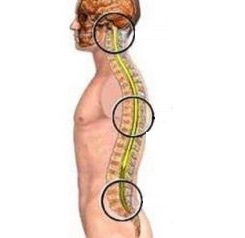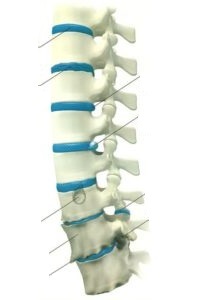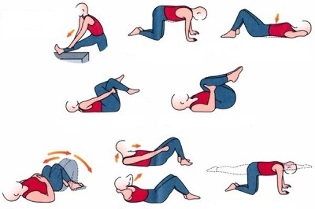Osteochondrosis of the spine, its symptoms and treatment are among the pathological processes of axial skeletal tissue, which have their own characteristics. The frequency of diagnosis of the disease does not decrease over time. What is lumbar osteochondrosis? This is a specific type of degenerative-dystrophic change in the tissues of the intervertebral discs of the joint skeleton with subsequent damage to the joints and ligaments. The photo shows the appearance of the affected spine.
Lumbar osteochondrosis, what is it?

The lumbar region of the axial skeleton is exposed to maximum tension. As a result, it is not accidental that a high diagnosis of osteochondrosis is present in this part of the spine.
The causes of lumbar osteochondrosis have long been known and well studied. The disease can manifest itself in patients from the age of 30 years. However, the older generation and the stronger half of the world community are more likely to encounter pathology.
Timely treatment of lumbar osteochondrosis provides an opportunity to prevent a decrease in work capacity, quality of life and disability.
Hypothermia and strenuous physical activity are strictly prohibited in sick patients. Weightlifting, speed skating, running, jumping, horseback riding, aerobics, motor sports are contraindications for osteochondrosis.
Causes of the disease
A number of external and internal factors cause signs of degenerative-dystrophic changes in the tissues of the intervertebral discs of the axial skeleton. Symptoms of lumbar osteochondrosis, including lumbar dorsalgia, cause anxiety, restlessness, and stiffness of movements.
Among the causes of pathological development should be noted:
- professional athletes and amateurs have increased the load on their lower back due to certain conditions for performing work tasks, repair work, lifting weights during training;
- execution of sharp, complex actions;
- overweight in women and men, which predisposes to the symptoms of lumbar pathology;
- hypothermia;
- incorrect posture causing uneven distribution of load on the axial skeleton;
- elasticity, a sedentary lifestyle that negatively affects the blood supply to each vertebra;
- inability to sit and move properly;
- congenital spinal pathologies or back injuries as a result of sports, falls from heights, traffic accidents;
- Lack of a balanced diet enriched with vitamins, minerals, trace elements, as well as proper organization of food intake, work, rest;
- regular stressful situations;
- hormonal disorders in women during pregnancy and menopause;
- Disorders of metabolic processes in the patient's body;
- genetic predisposition that determines the porous-loose structure of spinal tissues and accelerates degenerative-dystrophic changes;
- Alcoholism, which accelerates the aging process in the human body, addiction to smoking tobacco products.
Straight legs, wearing uncomfortable shoes, vitamin deficiencies, and poor environmental conditions are also causes of lumbar osteochondrosis. Exclusion of a number of factors will help prevent the development of pathology. When confirming the diagnosis of lumbar osteochondrosis, immediate treatment without waiting for complications is recommended. Ignoring the recommendations of qualified specialists leads to dorsalgia and other complications. Vertebrologists know how to treat osteochondrosis of the lumbar axial skeleton and provide first aid as soon as possible for acute pain.
Symptoms of the disease

The lower back is an important part of the waist. Timely diagnosis of lumbar osteochondrosis, which is recommended to start treatment as soon as possible, eliminates the risk of unpleasant consequences. Axial skeletal degenerative-dystrophic disease has certain symptoms.
Symptoms of lumbar osteochondrosis are included in a special list. The most common are:
- inability to perform back curves, torso rotations;
- Decreased elasticity, mobility of the lumbar spine, which can be treated at home, taking into account the recommendations of the doctor;
- depression;
- symptoms and treatment of osteochondrosis of the lumbar spine with its own characteristics, increased fatigue, irritability, irritability;
- dorsalgia in the lumbar region, which causes problems when performing daily hygiene procedures, urination, defecation;
- problems with night rest;
- increased sweating;
- Feeling of nausea and chills in the lower extremities.
Such symptoms of lumbar osteochondrosis indicate the need to seek professional help. Vertebrologists will always help to treat this disease, to improve the lives of patients, to get rid of dorsalgia, anxiety, stiffness and anxiety.
Complications of the disease
Long-term degenerative-dystrophic changes in the tissues of the intervertebral discs of the axial skeleton without proper treatment lead to complications and accompanying pathologies of the internal organs of patients. Timely diagnosis of lumbar osteochondrosis, which indicates the need for the help of a vertebrologist, eliminates the risk of recurrence. Ignoring the recommendations of the attending physician causes new problems related to health, well-being and quality of life.
Complications of lumbar osteochondrosis that should be treated without waiting for dorsalgia include confirmation of the diagnosis include:
- menstrual disorders in women and sexual activity in men;
- spasm of varicose veins and leg veins;
- dysfunction of the genitourinary system;
- sciatic nerve irritation and neuralgia;
- pain in the kidneys and dorsalgia in the lower back;
- protrusions of the intervertebral discs and the spine itself and herniated protrusions;
- radiculitis, acute and chronic lumbodynia, disability.
Unpleasant consequences of lumbar osteochondrosis, in the absence of proper treatment, lead to mental disorders, depression and deterioration of quality of life, not only the patient himself, but also those around him, relatives and loved ones. It is also desirable to have information on how to diagnose osteochondrosis.
Stages of the disease
When asked if it is possible to treat osteochondrosis of the spine, vertebrologists say yes, provided they see a doctor in time. They distinguish four stages in the development of the disease, each of which manifests itself at a certain time and has its own characteristics. These include:
- Stage 1characterized by mild pain, aggravated by physical force, discomfort in the lumbar region, the onset of destruction of the intervertebral discs; Stage 2 of the disease
- is characterized by a decrease in the distance between the vertebrae due to pathological changes in the fibrous rings, compressed nerve processes, severe pain in lumbar osteochondrosis;
- Stage 3 of the disease, among the symptoms of which are severe destruction of fibrous rings, the formation of hernia protrusions, significant deformation of the axial skeleton;
- Stage 4 of the diseaseis characterized by serious motor problems in a patient who has to be treated for lumbar osteochondrosis at home or in the hospital and is at risk of disability.
Pathological diagnosis
Patients are advised to know which doctor treats osteochondrosis of the spine and how to treat osteochondrosis of the spine at home. After collecting the medical history of the patient, which is an external examination, the vertebrologist prescribes diagnostic measures. Their list includes:
- clinical, biochemical blood test;
- X-ray, which allows you to get information about the condition of the axial skeleton and prescribe treatment for osteochondrosis of the spine at home or in the hospital;
- Computed tomography, which is characterized by less radiation load on the body, allows a more detailed study of the pathological zone of the axial skeleton and answers the question of whether osteochondrosis can be treated at this stage of development;
- Magnetic resonance imaging based on the use of electromagnetic radiation provides a completely painless, harmless examination of the back in osteochondrosis of the spine.
Modern diagnostic methods are one of the most informative research methods. Their results are the basis for confirming the diagnosis of lumbar osteochondrosis, the symptoms of which indicate the presence of a spinal problem, and at the same time allow to determine the correct treatment for axial skeletal pathology.
How to fight osteochondrosis and how to get rid of its symptoms?
Vertebrologists who know how to treat lumbar oxial osteochondrosis at home will always come to the aid of sick patients. After receiving the results of the examination of the pathological zone of the spine, a number of measures are prescribed to eliminate the symptoms of the disease and prevent the development of complications. Treatment regimens for lumbar osteochondrosis are developed taking into account the age category of the patient, the structural features of the skeleton of the axis. Allergies that can manifest themselves in the background of taking the drug are also identified.
The main measures for the effective treatment of osteochondrosis include:

- Drug treatment based on non-steroidal anti-inflammatory drugs, hydroprotectors, muscle relaxants, vitamin complexes, phytopreparations;
- treatment is the implementation of blockages that relieve severe pain in lumbar osteochondrosis with its own symptoms;
- recommended regular water treatments and axial skeletal elongation;
- medical massage;
- Exercises designed to strengthen the muscle frame make the vertebrae more mobile and do not question how to treat lumbar osteochondrosis;
- to use traditional medicine prescriptions.
Treatment of lumbar osteochondrosis is carried out against the background of a balanced diet and diet. Giving up bad habits is also a necessary measure to prevent the development of the disease. Orthopedic prevention of lumbar osteochondrosis allows to prevent surgical intervention.





































